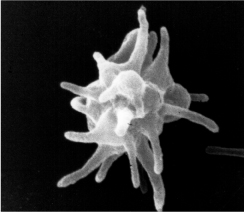When I started my platelet research I followed an established protocol: I collected blood in sodium citrate, centrifuged the blood, and removed and fixed the platelet-rich plasma. I performed all steps at room temperature. Dr. Pfeiler, an expert in electron microscopy, helped me "see" platelets when I started to work with them. We were appalled by the sight of the first images of washed and fixed, "resting" platelets. What had I done to them?
During my chemistry undergraduate and my master's in physical chemistry I did not learn a lot about platelets. I really had no idea what had happened that they didn't have a discoid and smooth shape. I started digging in the literature and found Guilio Bizzozero's paper published in 1882 showing hand drawn discoid platelets as they closed a wound.1
It took months of learning with Prof. Gustav Born and Sir John Vane and their teams in London, UK, reading many papers and performing many experiments to learn that platelets are very temperature sensitive—with sodium citrate as anticoagulant they activate already at room temperature! Much stronger anticoagulants like acid citrate dextrose (ACD) are required to prevent the temperature activation of platelets. ACD reduces the pH and captures much more calcium than sodium citrate alone. As blood bankers know, even with the strong anticoagulants used in platelet transfusions, platelets will activate when kept in the fridge, i.e., at 4°C.2
The high concentration of a calcium-binding component like sodium citrate prevents blood from clotting and platelets from activating. The protons from citric acid that cause the low pH of strong anticoagulants keep platelets busy dealing with this imbalance because it is absolutely necessary to maintain the intracellular pH. Thus, strong anticoagulants "distract" platelets from responding to stress like low temperature.3 The temperature sensitivity of platelets has practical consequences. Platelets for transfusion need to be stored between 20-24°C rather than 4°C in order to prevent stress from cold exposure.

"The spiky platelets are activated platelets—the weak anticoagulant I used did not prevent them from sensing and responding to low temperature stress."
